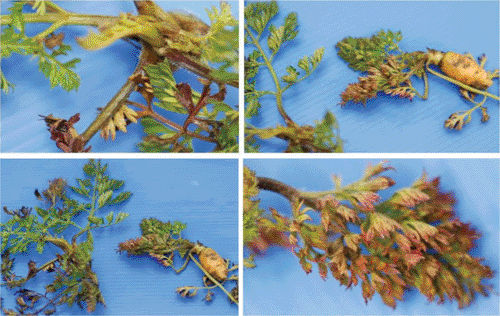First report of Carrot red leaf virus-associated RNA co-infecting carrot with Carrot red leaf virus and Carrot mottle mimic virus to cause carrot motley dwarf disease in New Zealand
J. Tang A B , B. D. Quinn A and G. R. G. Clover AA Plant Health and Environment Laboratory, MAF Biosecurity New Zealand, PO Box 2095, Auckland 1140, New Zealand.
B Corresponding author. Email: joe.tang@maf.govt.nz
Australasian Plant Disease Notes 4(1) 15-16 https://doi.org/10.1071/DN09006
Submitted: 24 August 2008 Accepted: 4 February 2009 Published: 18 February 2009
Abstract
Carrot plants with severe leaf reddening and stunting symptoms caused by carrot motley dwarf disease were observed in the South Island of New Zealand. Carrot red leaf virus (CtRLV), Carrot mottle mimic virus and CtRLV-associated RNA (CtRLVaRNA) were shown to be the components of the virus complex causing the disease. CtRLVaRNA is reported for the first time in New Zealand.
Carrot motley dwarf (CMD) disease causes sporadic but severe losses in early carrot (Daucus carota) crops under cool climatic conditions (Watson and Falk 1994). CMD disease has recently been described as being caused by a complex of three viruses: Carrot red leaf virus (CtRLV), CtRLV-associated RNA (CtRLVaRNA), and either one of two umbraviruses, Carrot mottle virus (CMoV) or Carrot mottle mimic virus (CMoMV) (Watson et al. 1998). In New Zealand, CMD disease has been observed since 1954 and was thought to be associated with CtRLV and/or CMoV (Pennycook 1989), or CtRLV and CMoMV (Gibbs et al. 1996).
In August 2007, carrot plants with severe leaf reddening and stunting symptoms (Fig. 1) were collected from a farm in the Canterbury region, in the South Island of New Zealand. Herbaceous indicator plants (Chenopodium amaranticolor, C. quinoa, Nicotiana clevelandii, N. tabacum and Phaseolus vulgaris) were inoculated with sap from diseased leaves and maintained in a glasshouse at a mean temperature of 18°C. Systemic chlorotic spotting and distortion symptoms were observed on N. clevelandii 14 days after inoculation. The other indicator species did not develop symptoms.

|
Nucleic acid was extracted from leaves of symptomatic carrot and N. clevelandii plants with an RNeasy Plant Mini Kit (Qiagen, Melbourne, Australia). The isolated RNA was used for cDNA synthesis using the SuperScript II RNase H-Reverse Transcriptase (Invitrogen, Carlsbad, CA, USA) following the manufacturer’s instructions. Polymerase chain reaction (PCR) was done in a 20-μL volume reaction containing 2 μL cDNA, 10 μL GoTaq Green Master Mix (Promega, Madison, WI, USA) and 0.25 μmol each of the forward and reverse primers. PCR products of the expected size (~740 bp and 430 bp) were obtained from both D. carota and N. clevelandii plants using a published CtRLVa-RNA-specific primer pair (CtRLVaRNA-1/CtRLVaRNA-2; Vercruysse et al. 2000), and novel CMoMV specific primers (forward 5′-AAAGGGCAAGGTATGAGCAA-3′, reverse 5′-TGAGCAGGTCCACAAACTCC-3′), respectively. An amplicon of 211 bp was obtained from D. carota using a CtRLV-specific primer pair (CtRLV-1/CtRLV-2; Vercruysse et al. 2000) but not from the inoculated plants of N. clevelandii. The PCR products were sequenced directly. Basic Local Alignment Search Tool (BLAST) searches in GenBank showed that the 740, 430 and 211 bp nucleotide sequences had 95%, 97% and 92–97% identities with CtRLVaRNA (GenBank Accession number AF020616), CMoMV (GenBank Accession number U57305) and CtRLV (GenBank Accession numbers AY695933, AY325503 and AY325505), respectively.
In order to determine if the second umbravirus, CMoV, was also co-infecting the symptomatic carrots, a PCR was performed using the umbravirus-specific primers (Umbra-NNS/Umbra-FDQH) reported by Vercruysse et al. (2000). A single product of 545 bp was obtained from the D. carota plants. The amplicon was cloned using TOPO TA Cloning Kit (Invitrogen, Carlsbad, CA, USA) and five clones were sequenced. The sequences were identical and had 96% identities with CMoMV (GenBank Accession number U57305), confirming that the sample was infected with CMoMV, not CMoV.
Initial reports of CMD disease in New Zealand suggested that the disease was caused by CtRLV and/or CMoV (Pennycook 1989). More recently, Gibbs et al. (1996) concluded that the disease was caused by CtRLV and/or either CMoV (in the UK and Morocco) or CMoMV (in New Zealand). This report supports the hypothesis that CMD disease in New Zealand is caused by a combination of CtRLV, CMoMV and CtRLVaRNA. CtRLVaRNA has been reported previously to be the third component of the CMD disease complex and is always present in CMD-affected plants in California, USA (Watson et al. 1998) and the UK (Morton et al. 2003). This is the first report of CtRLVaRNA in New Zealand. The study found no evidence for the presence of CMoV in the samples studied but further research is required to clarify whether the virus is present in New Zealand.
Morton A,
Spence NJ,
Boonham N, Barbara DJ
(2003) Carrot red leaf associated RNA in carrots in the United Kingdom. Plant Pathology 52, 795.
| Crossref | GoogleScholarGoogle Scholar |

Vercruysse P,
Gibbs M,
Tirry L, Höfte M
(2000) RT-PCR using redundant primers to detect the three viruses associated with carrot motley dwarf disease. Journal of Virological Methods 88, 153–161.
| Crossref | GoogleScholarGoogle Scholar |
CAS |
PubMed |

Watson MT, Falk BW
(1994) Ecological and epidemiological factors affecting carrot motley dwarf development in carrots grown in the Salinas valley of California. Plant Disease 78, 477–481.

Watson MT,
Tian T,
Estabrook E, Falk BW
(1998) A small RNA resembling the beet western yellows luteovirus ST9-associated RNA is a component of the California carrot motley dwarf complex. Phytopathology 88, 164–170.
| Crossref | GoogleScholarGoogle Scholar |
CAS |
PubMed |



